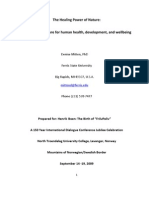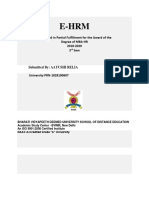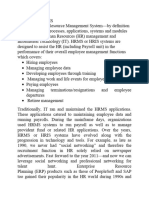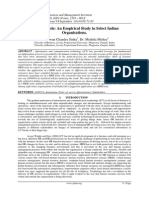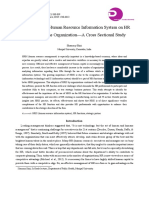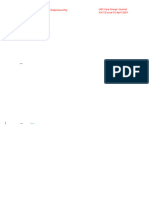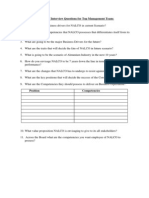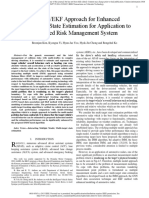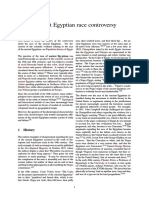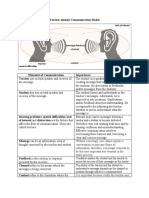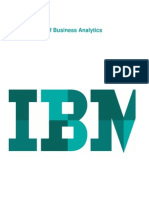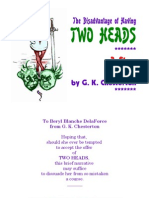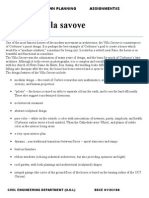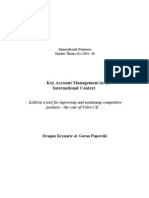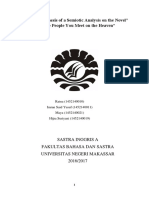Ukessays - co.Uk-eHRM Electronic Human Resource Management
Ukessays - co.Uk-eHRM Electronic Human Resource Management
Uploaded by
srushtimohapatraCopyright:
Available Formats
Ukessays - co.Uk-eHRM Electronic Human Resource Management
Ukessays - co.Uk-eHRM Electronic Human Resource Management
Uploaded by
srushtimohapatraOriginal Description:
Original Title
Copyright
Available Formats
Share this document
Did you find this document useful?
Is this content inappropriate?
Copyright:
Available Formats
Ukessays - co.Uk-eHRM Electronic Human Resource Management
Ukessays - co.Uk-eHRM Electronic Human Resource Management
Uploaded by
srushtimohapatraCopyright:
Available Formats
uke ssays.co .uk http://www.ukessays.co .uk/essays/info rmatio n-system/e-hrm-electro nic-human-reso urce-management.
php
e-HRM electronic Human Resource Management
Chapt er one: Int roduct ion 1.1. Background:
Since the mid 1990s, organizations increasingly introduce electronic Human Resource Management (HRM). It has dif f erent names, f or example e-HRM, digital HRM and web-based HRM. T he rapid development of the Internet during the last decade has also boosted the implementation and application of electronic Human Resource Management (e-HRM). Surveys of HR consultants suggest that both the number of organizations adopting e-HRM and the depth of applications within the organizations are continually increasing (e.g. CedarCrestone, 2005) in world wide. In addition, an escalating number of practitioner reports provide anecdotal evidence that e-HRM is becoming increasingly common and may lead to remarkable changes (e.g. Anonymous, 2001). Consequently, academic interest in e-HRM has increased, as several special issues of HR-related journals demonstrate (Stanton & Coovert, 2004; Townsend & Bennett, 2003; Viswesvaran, 2003). In the interim, there is an initial body of empirical research in e-HRM. However, since this research stems f rom several disciplines and is scattered throughout numerous journals and since initial reviews are not encompassing (Anderson, 2003; Lievens & Harris 2003; Welsh, Wanberg, Brown, & Simmering, 2003), the results of these studies remain unclear at present. Furthermore, changes in the role that HR f ulf ills in the organization and the implementation of e-HRM are related to each other, and should not be considered separately (Gardner et al., 2003; Fletcher, 2005). T he implementation of e-HRM should f it well with strategic organizational needs regarding personnel in general and HR redesign in specif ic. Little is known about this f it, however. In relation to this point, the possible perception of e-HRM as an attempt by the strategic level within the organization to of f load operational HR work onto employees respectively managers should be taken into account when analyzing acceptance of eHRM systems. In the last decade the Internet has radically changed our social and economic lives, and has had a prof ound ef f ect on the way organizations are managed. For example, it has altered human resource (HR) practices and changed strategies f or attracting and retaining employees. T he same strategies have become particularly important because organizations increasingly depend on workers' knowledge, skills, abilities, and other attributes (KSAOs) to compete in today's economy (Ulrich, 2001) in Oman. In addition, the Internet has enabled organizations to become more collaborative, connected, and responsive to the changing needs of the workf orce. For instance, new electronic human resource (e-HR) systems allow individuals to apply f or jobs, change their job-related benef its, and enhance their knowledge, skills, and abilities (KSAs) through web-based training systems. T he type of inf ormation technology adopted by HRM has been phrased, as it has evolved, dif f erently over the years, f or example: Human Resource Inf ormation System (HRIS), Human Resources Management System (HRMS), Human Resource Development And Inf ormation Technology (HRDIS), and the most current and popular "electronic HR" (e-HR). T he use of IT by HRM is growing especially critical to the business nowadays when discontinuities (mergers, acquisitions, restructuring and downsizing) are altering the industry landscape in a drastic way. HRM executives, the key f igures in organizations responsible f or f ine-tuning a capable workf orce, must have the right and real-time inf ormation to measure, manage, and predict how workf orce should be allocated and reconf igured ef f ectively. With the analyzed inf ormation produced by the IT, HR prof essionals, more than ever, are able to align their management goals and the goals of individual employees with corporate strategy to deliver strategic plans with quantif iable results, and, ultimately, be able to deal with changes proactively. With the help f rom the inf ormation technology, HRM prof essionals are also able to demonstrate the HRM's benef it to the bottom line by ef f ectively managing knowledge, skills and abilities (KSAs) that create winning companies.
Human resource management (HRM) departments using inf ormation and communication technologies (ICTs) is becoming an increasingly important phenomenon commonly ref erred to as e-HRM. Automating HR tasks and practices is transf orming the traditional paper-and-pencil, labor-intensive HR tasks, into ef f icient, f ast-response activities that enable companies to anticipate and prof it f rom environmental shif ts to create a much needed competitive advantage (Marler, 2006; Watson Wyatt, 2002). Even though the e-HRM concept is widely used today, there are hardly any explicit def initions. T he f ew detectable def initions (Lengnick-Hall & Moritz, 2003; Rul, Bondarouk, & Looise, 2004) are rather general and emphasize the Internet-supported way of perf orming HR policies and/or activities. Leaning on these intensions, the f ollowing def inition of e-HRM can be specif ied: e-HRM is the (planning, implementation and) application of inf ormation technology f or both networking and supporting at least two individual or collective actors in their shared perf orming of HR activities. T his concept highlights several crucial aspects of e-HRM. At the outset, e-HRM utilizes inf ormation technology in a twof old manner: First, technology is necessary to connect usually spatially segregated actors and enable interactions between them irrespective of their working in the same room or on dif f erent continents, i.e. technology serves as a medium with the aim of connection and integration. Second, technology supports actors by partially - and sometimes even completely - substituting f or them in executing HR activities. Hence, inf ormation technology serves additionally as a tool f or task f ulf illment. T he planning aspect accentuates the systematic and anticipated way of applying inf ormation technology. T he shared perf orming of tasks through at least two actors' points out that the sharing of HR activities is an additional f eature and underlines the aspect of interaction and networking. T he consideration of individual and collective actors takes into account that e-HRM is a multilevel phenomenon; besides individual actors, there are collective actors like groups, organizational units and even whole organizations that interact in order to perf orm HR activities. Beside e-HR(M), there are some f urther concepts which obviously ref er to the same phenomenon. Widely accepted are such terms as virtual HR(M) (e.g., Lepak & Snell, 1998), web-based HR(M) (e.g., Rul et al., 2004), or business-to-employee (B2E) (e.g., Huang, Jin, & Yang, 2004). Virtual HRM ref ers to technological mediated networks of dif f erent internal and external actors providing the f irm with the HR services needed without the f urther existence of a conventional HR department which theref ore becomes virtual. E-HRM is additionally open to less developed varieties of technology application, e.g. the shared perf orming of an application process by a conventional HR department and an applicant via the Internet. Web-based HRM couples the concept to Internet technologies. E-HRM, as well, is particularly web-orientated, but also comprises additional technologies like networked ERP-Systems. Finally, business-to-employee reduces the concept to the internal actor categories of business (presumably line managers and HR prof essionals) and employees. In contrast, e-HRM is open to f urther relevant actor categories like applicants or consultants. To sum up, these f urther terms undoubtedly direct attention to main characteristics of the same phenomenon but are of somewhat narrower intensions. T hus, in order to comprehensively embrace relevant aspects, the e-HRM term is used. Fundamental def inition of HRM of f ered by numerous scholars remains to be "the managing of people who work in an organization" (Gomez -Mejia, Balkin & Cardy, 2001). Another popular def inition of HRM specif ied the "top management of the corporation" as the only employer of the HRM staf f (Renckly, 1997). Based on this thinking, HRM is "to essentially establish, develop, maintain, and communicate personnel policies to the entire company", and thus, "to represent, help, advise, and consult with the employees of the organizations". It is apparent that HRM was def ined f rom an employer perspective, and was expected to serve and represent "f irst, last and always" the best interests of their "only employer": top management. Beer and Spector (1985), representing another group of researchers and HRM practitioners, def ined HRM f rom the "relationship" perspective as the management of this relationship between employees and the organization which, more specif ically, "involves all management decisions which af f ect the nature of the relationship between the organization and employees its human resources". Nadler (1990), on the other hand, def ines HRM f rom an organizational learning point of view as: the "organized learning experience in a def inite time period to increase the possibility of improving job perf ormance and growth".
As human resource (HR) management departments continue to move to internet or web-based technology (T he Hunter Group, 2001), more research evaluating the use of web-based HR, or electronic human resource management (e-HRM) is needed. T he f astest growing trend in the delivery of HR inf ormation is employee self -service (ESS) (Gueutal, 2003). T hese applications give employees the ability to access and maintain their personal HR inf ormation via the web. Another growing trend is the adoption of managerial self -service (MSS) which provides managers access to a variety of HR tools and inf ormation via the web (Gueutal, 2003). Most manager HR-related tasks can be completed via MSS applications including pay administration/compensation, perf ormance management, staf f ing, and employee development (Gueutal, 2003). Another term used to describe these tools utilized within a given organization is human resource inf ormation systems (HRIS), which Kavanagh and T hite (2008) def ine as the system used to acquire, store, manipulate, analyse, retrieve, and distribute inf ormation regarding an organization's human resources. Lepak and Snell (1998) ref er to the f our pressures' of virtual HRM. First of all, HRM departments are asked to f ocus on strategic questions. Secondly, these departments need to be f lexible in terms of policymaking and practices. T hirdly, HRM departments should work ef f iciently and be aware of costs. Fourthly, HRM departments should be service-oriented towards management and employees. In short, HRM departments must be strategy-f ocused, f lexible, ef f icient, and client oriented; and all at the same time (Lepak and Snell, 1998). Rul et al. (2004) highlighted an aspect that is f airly well covered by the above but that is nevertheless interesting to spell out, namely the changing nature of the employment relationship. With the supply shortage in the labor market (during the economic upturn of the 1990s), the individualization of society, and the increased educational level of citizens (and thus of employees), the power balance in the employment relationship has shif ted in the direction of the employees: they want to steer their own career paths. In the view of Rul et al. (2004), a move towards e-HRM can provide the tools to support this development. T his aspect f its into earlier-mentioned drivers such as improving service towards internal clients, but has an external societal drive. Yet another goal of e-HRM was stressed as the outcome of the case study research conducted by Rul et al (2004): it is necessary to recognize that to improve a company's global orientation can become a strong drive to start with e-HRM. T heoretical debates suggest three goals of e-HRM are cost reduction, improving of HR services, and improving strategic orientation (Brockbank, 1997; Lepak and Snell, 1998; Stanton and Coovert, 2004). Few empirical f indings supplement these goals with globalisation as a driving e-HRM f orce in international large organisations, but also show that those goals are not clearly def ined in practice, and that e-HRM mostly directed at cost reductions and ef f iciency of HR services, and least - at strategic orientation of HRM (Gardner et al, 2003; Rul et al, 2004; Ruta, 2005). HRM ef f ectiveness is of ten mentioned as HRM contribution to f irm perf ormance (see, f or ex., Kane et al, 1999; Ostrof f and Bowen, 2000; Wright et al, 2001). Especially during the past decade the HRM literature made attempts to show that progressive HR practices result in higher f irm perf ormance (Wright et al, 2005; Hope Hailey, 2005). Huselid's (1995) pioneering study has shown that a set of HR practices labelled High Perf ormance Work Systems were related to turnover, accounting prof its, and f irm market value. Since then, a growing number of studies have attempted to empirically test the relationships between HR practices and f irm perf ormance (see elaborated overviews by Delery and Doty, 1996; Ostrof f and Bowen, 2000; Boselie et al, 2001; Tsui and Wang, 2002; Wright et al, 2005). For example, MacDuf f ie (1995) has f ound that bundles of HR practices were related to productivity and quality in his sample of auto assembly plants. Delery and Doty (1996) f ound signif icant relationships between HR practices and accounting prof its among a sample of banks. Youndt et al (1996) discovered that certain combinations of HR practices in their sample of manuf acturing f irms were related to operational perf ormance indicators. More recently, the study of Batt (2002) examined the relationship between HR practices, employee quit rates, and organizational perf ormance in the service sector, and revealed that quit rates were lower and sales growth was higher in call centers that emphasized high skills, employee participation, and human resource incentives like high employment security.
1.2. Problem St at ement
One of the principal and most integral objectives of Oman's Vision 2020 is the development of Human Resources. T he importance of Human Resource Development (HRD) has been given top priority throughout the Sultanate of Oman's successive Five-Year Development Plan. In Oman's vision 2020; economic conf erence held in Muscat in June, 1995, His Majesty's address to the nation clearly emphasized the need f or the private sector to undertake an active role in the development of the economic process and in the achievement of the national goals. Nonetheless, this was not considered in isolation f rom the development of the national human resources, but rather in conjunction as proclaimed by His Majesty Sultan Qaboos Bin Said: "Development is not a goal in itself rather; it exists f or building man, who is its means and producer. T heref ore, development must not stop at the achievement of a diversif ied economy. it must go beyond that and contribute to the f ormation of the citizen who is capable of taking part in the process of progress and comprehensive development." (Vision 2020 Conf erence, June, 1995). In Oman, now as never bef ore, the training and development of national (Omani) human resources to a high level of ef f iciency & competency is a must. T his is due to a number of reasons including less dependence on oil resources, less dependence on f oreign (expatriate) workers, Omanization, implementation of a successf ul privatization program, diversif ication, industrialization, technological innovation and an increasingly competitive global market. To meet the goal of Vision 2020, electronic human resource management is the one of the essential part f or the development of the human capital. In this sense it is quite dif f icult f or ef f ective e-HRM in f irms in Oman. Technologically it will be new to the f irms in Oman. Henson (2005) identif ies workf orce and technology as the "heartbeat and the toolset of the HR business today". HRM is no doubt the business unit most directly responsible f or the managing and the developing of the workf orce, theref ore, f actors and trends that trigger the workf orce changes need to be addressed with care. Researchers in 21st century have come to the realization of the greatest workf orce crisis: the aging of the industrialized world (Dychtwald, Erickson & Morison, 2006), resulting in an "unprecedented shif t in the age distribution of the general population and, specif ically, the labor f orce".
1.3. Research Quest ion:
1. Does an e-HRM tool af f ect e-HRM f unction? 2. Is there any relationship between e-HRM tools and HRM f unction? 3. Is there any relationship between HRM f unction and f irm perf ormance in e-HRM practice?
1.4. Research Object ive:
Main objective of this study is to investigate the e-HRM ef f ectiveness in oil industry in Oman. * To investigate whether the e-HRM tools and HRM f unction are related * To investigate whether e-HRM tools af f ect the HRM f unctions * To investigate whether e-HRM has an ef f ect on f irm perf ormance
1.5. Signif icant of t he St udy
T his study will provide the human resource prof essional to more ef f ective way to implement the human resource f unctions implementation in oil industry in Oman. T his study also identif ied e-HRM f eatures that deserve HRM practitioners' attention and organizational resources. T his in-depth examining of the set of e-HRM f eatures can also serve as potential tools f or the management to decide on the f uture adjustments of their e-HR system, and the implementation of the new systems. From a practical perspective, result like perf ormances, either yielded by certain business division like HRM or by organizations, ref lects an organization's capabilities in implementing competitive strategies and tools, and aligning its resources and goals. T heref ore, by establishing and learning the relationships among the use of e-HRM system, the perceived importance of e-HRM f eatures, HRM's f unctional perf ormances organizational perf ormances, and the perceived importance of the dimensions of the organizational perf ormances, HRM practitioners shall be able to manage IT-related issues more ef f ectively, and benef it better f rom the use of e-HRM. Although this study will be based on the oil industry in Oman; but the f inding can helps the other organization also such as education, manuf acturer etc. to practice human resource f unction through online more ef f ectively.
1.6. Scope of t he st udy
We only use the technology f actors and the HRM f unction implementation through online f or HRM ef f ectiveness in this study. T here are some other opportunities f or researcher to conduct the research on e-HRM ef f ectiveness in Oman. T hey can add the strategic part of organization with these variables in f uture. Strategic variable such as the organization goal, objectives and so on can be considered f or f urther study. . Beside this the technology f actors such as system implementation also can be included.
1.7. Limit at ion of t he St udy
In this study one of the major problems is about the sample. T his study can take larger sample than it will be taken. An also the time is another limitation f or conducting this research. Shortage of time make researcher to consider the sample f or this dissertation in f ew f irms only. Beside that money allocation is another problem f or this research. Researcher is using his own money to conduct this study. So that he cannot cover the wide area of or many more f irm f or analyze.
1.8. Organisat ion of t he st udy: Chapt er t wo: Lit erat ure Review 2.1. Theoret ical perspect ives
Given dif f erent interpretations and assessments of theory, there is an ambiguity concerning theories, f rameworks and other phenomenological conceptualizations. Even acknowledging a broad intension of theory, only one-f if th of the studies rest on theoretical bases. Corresponding to the diverse disciplines and topics, the theories employed are also quite diverse. Of ten, several perspectives are employed in an eclectic manner. Predominantly, micro-level theories of psychological and behavioral provenance are adopted. Attribution theory and correspondence inf erence theory (Elgin&Clapham, 2004), the attractionselection-attrition and the similarity-attraction paradigm (Dineen, Ash, & Noe, 2002), change management theories (Ruta, 2005), organizational citizenship behavior (Huang, Jin, et al., 2004), privacy theories (Harris, van Hoye,&Lievens, 2003), procedural justice theory (Dineen,Noe,& Wang, 2004), signaling theory (Cober,Brown Levy,&Cober 2003), as well as social cognitive theory (Williamson, Lepak, & King, 2003) are adopted in order to explain individual perceptions and reactions arising f rom e-HRM. Additionally, a learning theory is adopted to compare instructor-led and web-based learning (Coppola & Myre, 2002). In addition, some theories stemming f rom inf ormation systems research are used. T he technology acceptance model (Huang, Yang, Jin, & Chiu, 2004), the unif ied theory of acceptance and use of technology (Ruta, 2005), and the theory of usability (Williamson, Lipak, & King, 2003) are used to f rame again problems of individual reactions and usage. Also, a conceptual IT-f ramework is used to structure e-HRM impacts on HRprof essionals (Gardner, Lepak, & Bartol, 2003). One single study pursues a microeconomic approach to explain e-employment markets (Nissen & Gates, 2004). In brief , current empirical research in e-HRM is mainly non theoretical. T he theories applied are micro-level oriented, diverse in nature and of ten eclectic in application. Interestingly, recognized macro-level theories of HRM (Wright & McMahan, 1992) were not considered.
2.2. HRM Ef f ect iveness
To know the ef f ectiveness of e-HRM, HRM f unctions are relatively come to the picture. T he American Society f or Personnel Administration (ASPA), the predecessor to SHRM, f irst def ined HRM f unctions in 1975 as the technical competencies in the f ollowing areas (HRCI, 2006): * Employment, placement and personnel planning. * Training and development. * Compensation and benef its. * Health, saf ety and security. * Employee and labor relations. * Personnel research. Smith and Mazin (2004) reports the scope of the HRM f unctions covers the f ollowing areas of f unctionality: * Employee selection * HR policies, perf ormance management * Perf ormance Management * Training and development * Employee relations and retention * Compensation * Benef its
* Workf orce violence and investigation * Termination and discharge Researchers also observed other dimensions to HRM as well, f or instance, Huselid, Jackson and Schuler (1997) reports that HRM ef f ectiveness has two essential dimensions. T he f irst, the technical HRM, includes the delivery of HRM basics such as recruiting, compensation, separation etc. T he second, strategic HRM, involves "delivering those services in a way that directly supports the implementation of the f irm's strategy". Other academia and HRM prof essionals are also inclined to analyze HRM f unctions f rom various perspectives, f or example: f rom the areas of activity (Nadler,1990), and f rom the areas of service rendered. Nadler (1990) f irst groups the HRM f unctions into three specif ic areas of activity: (1) training, which implies "learning related to present job", (2) education, which implies "learning to prepare the individual f or a dif f erent but identif ied job", (3) development, which implies "learning f or growth of the individual, but not related to a specif ic present or f uture job". T his f urther reinf orces the thinking of HRM being learningdriven.
2.3. Implement at ion e-HR
Kehoe, Dickter, Russell and Sacco (2005) points out that the organization's overall culture and HRM strategy determine the manner in which organizations will implement their e-enablement systems. T he eenabled programs can either be implemented as part of a broad e-enablement of HR processes and systems, or implemented independent of other HR processes and systems. It is even possible that specif ic e-enabled assessment applications may be implemented independent of each other. No matter what, organizations need to develop guiding principles regarding the f ollowing issues on the management of an e-enabled HR environment: * Risk management relating to employment discrimination * Buy versus build and the roles of internal HR IT and third party providers * HR expertise versus automaticity in the e-enabled assessment process * Whose f unctions the system will be designed to support * Ownership * T he integration of e-enabled assessment with other HR systems and process * "Free market" versus "regulated" processes
E-recruit ment
In terms of the organization's objectives, the primary goal of the recruitment process is to attract potential applicants (prospects) who have the KSAOs needed to meet the requirements of organizational roles. T hus, organizations are increasingly using the Internet to advertise job openings and attract qualif ied prospects. T he web-based advertisements of ten provide prospects with inf ormation about (a) job vacancies, (b) job descriptions, (b) the organization's culture and its brand identity, and (d) the inducements (e.g., pay, f ringe benef its, learning opportunities, promotion prospects) of f ered its employees. Interestingly, some estimates indicate that 100%of large f irms currently use the Internet to announce job openings, and 82% of large f irms use intranet systems to post openings or identif y qualif ied employees within the organization (Cedar, 2002). For example, organizations have developed sophisticated web-based recruiting systems to convey inf ormation about job opportunities and give applicants the ability to complete applications online (Stone, Johnson, Navas, & Stone- Romero, 2005; Stone, Lukaszewski, & Isenhour, 2005). In addition, organizational intranet systems are of ten used to search employment records to determine if the KSAOs of current employees are consistent with the requirements of vacant or soon-tobe vacant roles. Such systemsmay automatically provide managers with lists of qualif ied employees, and notif y individuals about new job opportunities. In addition, the same systems may send messages to employees that ask about their interests in job openings. Overall, e-HR-based recruiting systems are thought to reach a much wider set of prospects than traditional recruiting systems (Gueutal & Stone, 2005; Stone, Lukaszewski et al., 2005). Internet-based e-HR systems are also used to provide job applicants (applicants) with virtual previews of organizations. For instance, some organizations use real time cameras to give prospects a preview of what it is like to work in the organization on a daily basis. Other organizations (e.g., Cisco Systems) use such systems to give job applicants the opportunity to make f riends in the organization. T hrough the resulting contacts, prospects can gather considerable inf ormation about the benef its and challenges of working f or the organization. As a result of the availability of inf ormation about role requirements and inducements, applicants can determine if their (a) needs can be satisf ied by of f ered inducements, and (b) KSAOs are likely to enable them to meet role requirements. T hough a great deal of organizations believe e-recruiting systems permit f irms to cast a wide net across a broad labor market, and is more likely than traditional recruitment sources to uncover individuals with unique talents and skills, researches show that e-recruiting only attracts greater numbers of candidates than other sources, but not necessarily attracts higher quality applicants or candidates who are most suitable f or the companies than traditional sources (Chapman & Webster, 2003; Galanaki, 2002). McManus and Ferguson (2003) discovers: given that some types of candidates may be more likely to use e-recruiting than the others (f or instance, "job hoppers" or savvy internet navigators), the use of the e-recruiting systems may actually af f ect the characteristics of new hires in organizations, and inf luence the overall composition of the workf orce. McManus and Ferguson (2003), Galanki (2002), Z usman and Landis (2002) f urther argue that there are age, gender, and ethnic dif f erences in reactions to and usage of online recruitment sources, theref ore, organizations should not use online recruiting as the sole recruitment sources.
E-Select ion
T here are three purposes f or all the HR e-enablement (Kehoe, Dickter, Russell & Sacco, 2005): (1) to minimize cost, (2) to maximize the utilization of the organization's human capital, (3) to enable sustainability which ref ers to the organization's willingness and ability "not only to maintain the e-enabled system, but to progressively evolve the system to satisf y changing requirements, and capitalize on improvements in technology and the science of selection". T he purposes f or e-enabling selection are no any dif f erent f rom the above. While conducting the maximizing the utilization of the organization's human capital, organizations are required to design two measures into the e-enabled selection system: (1) the "capital" represented by each person who goes through the process (including the set of text scores, interview ratings, resum6 quality indices, background check results, drug test results, and any other quantif iable evaluation of the skills, experiences, abilities.. ..etc.), and (2) "the extent to which the process results in decisions that maximize the utilization of that capital" (f or example, ratio or dif f erence between average test scores f or selected candidates to average test scores f or all candidates, percentage of candidates who satisf y minimum requirements such as f or drug tests or background checks, retention rates, post-hire, new hire perf ormance management results.. ..etc.). Organizations also need to enable sustainability by emphasizing on: clear ownership, f unding strategy, business contribution, user satisf action, and prof essional support. As f or the implementation, Kehoe, Dickter, Russell and Sacco reports that more and more organizations nowadays pref er to acquire a vendor's e-selection system because of the appealing f eatures of specialized and f lexible system solution products available on the market.
E-Perf ormance Management
Researchers have previously compared online administrations and traditional paper-and-pencil (P&P) administrations of organizational surveys (T hompson et al., 2003), measurement of psychological constructs (Cole et al., 2006), upward f eedback ratings (Smither et al., 2004), and item responses to a 3608 assessment (Penny, 2003). Whereas researchers have contrasted online versus P&P groups' reactions to selection tools (Richman-Hirsch et al., 2000), no research has compared online versus P&P administrations in the context of perf ormance appraisal (PA). Although f requently def ined as a measurement instrument or tool, PA is the social and communication process in which a supervisor evaluates an employee's behavior in the workplace and communicates those ratings and f eedback back to the employee (Murphy and Cleveland, 1995). T he purpose of this study is to address this gap in the applied research literature and examine the extent to which an online PA system inf luences employees' reactions to their PA. We believe this is an important applied research question that HR managers need to know the answer to bef ore implementing eHRM/HRIS PA tools. T hough Cardy and Miller (2005) argues that "the level of perf ormance made possible by technological advancement has changed the standard f or acceptable perf ormance", appraisal satisf action remains a relevant concern f or organizations even when technology is either a primary mechanism f or the f eedback process, or already "become" the appraisal process, because high-quality perf ormance f eedback is a critical f actor that helps organizations retain, motivate, and develop their employees, and, "these outcomes are more likely to occur if employees are satisf ied with the perf ormance appraisal process, f eel they are treated f airly, and support the system" (Ilgen, Fisher, & Taylor, 1979). Technology contributes to appraisal satisf action through contributing to perf ormance management in two primary ways (Cardy & Miller, 2005): (1) technology f acilitates measuring an individual's perf ormance via computer monitoring in an unobtrusive yet mechanical manner which only requires minimal input f rom individuals beyond their task perf ormance (f or instance, data collected f rom a call center or data entry jobs by number of keystrokes, error rates, time on task.
An online PA system is a sof tware program that f acilitates the completion of perf ormance evaluations online. It can be an MSS tool such that only managers have access to this system or it can be a combination of MSS and ESS, in which employees also have access and can provide inf ormation into the system. An online PA system can be more than the traditional P&P f orm placed on the web in that it may be integrated with an employee position description module, allowing managers to pull data f rom the employees' position description and insert this inf ormation into the evaluation (People Admin, 2006). Further, it can act as a historical archive, storing past evaluations and permitting comparisons between evaluations over time. T he primary advantage of these systems is the accessibility of the data any time f rom any computer with internet access, as well as the ease and speed with which they can generate accurate HR-related reports (Kavanagh and T hite, 2008). Such systems also of f er HR managers the opportunity to readily monitor the extent to which supervisors complete their employees' PAs on time, in addition to making it easier f or them to examine trends in perf ormance ratings.
E-Compensat ion
Dulebohn and Marler (2005) reports that the decline in lif elong employment relationships and internal labor market, added with the switch to the f latter organizational structures since 1990s has increased the prominence of competitive compensation in attracting and motivating critical human capital in the US. T his f urther necessitates a "closer linkage with the external market and the tools to make rapid changes in compensation in order to remain competitive and attractive to current incumbents and prospective employees". E-Compensation represents a web-enabled approach to an array of compensation tools that enable an organization to "gather, store, manipulate, analyze, utilize, and distribute compensation data and inf ormation" (Dulebohn & Marler, 2005). Unlike previous compensation sof tware, the e-compensation tools is web-based, rather than client-server based or stand-alone PC-based. T his allows individual's access electronically distributed compensation sof tware, databases, and analytic tools by using an internet browser f rom literally anywhere on the earth. E-Compensation tools can provide HR managers with the ability to ef f ectively adapt compensation systems to meet the current challenges, manage and maintain all aspects of equity in pay plan design, and to align the compensation systems with the strategic management of the organization. Dulebohn and Marler (2005) names three key ways in which e-Compensation tools help the HRM prof essionals in dynamic and competitive environment: (1) increase access to critical compensation inf ormation (f or example: knowledge management databases, best practices internal and external, individual equity design, competitive inf ormation) by simply on an as-needed basis without dedicated IT staf f s and sophisticated IT inf rastructures, (2) enable round-the-clock availability of meaningf ul compensation inf ormation to managers and employees company-wide, thus making critical compensation inf ormation more available to support decision making, (3) streamline cumbersome bureaucratic tasks through the introduction of workf low f unctionality and real-time inf ormation processing, so the HRM prof essionals' productivity can be increased. E-compensation systems also allow managers to develop budgets, model the impact of incentive systems, and ensure the f airness of salary allocation decisions (Dulebohn &Marler, 2005; Stone et al., 2003). For instance, such systems give managers access to salary data that can be used f or budgeting and modeling the costs of incentive systems with dif f erent components (e.g, prof it sharing,merit increases, stock options). Furthermore, these systems can be linked to e-perf ormance management systems, increasing the odds that pay raises are based on employee perf ormance. Moreover, they can be used to ensure that compensation systems have internal and external equity (Dulebohn &Marler, 2005). Interestingly, research shows that high perf orming companies are more likely to share details about their compensation systems with employees than low perf orming companies (Gherson & Jackson, 2001). In addition, research reveals that individuals have higher satisf action and retention levels when pay systems are perceived as f air (Bergmann & Scarpello, 2002).
Organizat ional Perf ormance
Huselid, Jackson and Schuler (1997) points out that there are two essential dimensions of the HRM: f irst, the technical HRM which includes the delivery of HRM basics such as recruiting and compensation; the second, the strategic HRM which involves delivering those services in a way that directly supports the implementation of the f irm's strategy. T he output of the implementation of the f irm's strategy is the "organizational perf ormances" adopted by the researcher in this research. Certain "value creation" should be ref lected in the process when HR do its part in managing human capital to f acilitate achievement of the operating objectives and the enterprise goals (Fitz-enz, 2002). Becker, Huselid & Ulrich (2001) argues mat: since there are dif f iculties in discerning HRM's actual contribution to overall mission and strategy of the organization, readers should view HRM's contribution to the overall organizational perf ormances through two aspects: HRM's strategic logic (linking HRM strategic measurement variables to implement the organizations' strategies), and HRM's strategic inf luence (elements of the HR system designed to maximize the overall quality of human capital throughout the organization). T heref ore, the multiple dimensions of the organizational perf ormances adopted in this research by the researcher are: stakeholders' satisf action, organizational communication, team collaboration, strategic perf ormance, knowledge management, and organizational growth. Huselid, Jackson and Schuler (1997), among many other researchers and HRM executives, reported that there are two essential dimensions of the HRM: f irst, the technical HRM which includes the delivery of HRM basics such as recruiting and compensation; the second, the strategic HRM which involves "delivering those services in a way that directly supports the implementation of the f irm's strategy". While both dimensions are equally essential, the strategic HRM plays an especially pivotal part in the overall HRM perf ormance, because, as stated in SHRM publication (2006): the weight of the "strategic perf ormances" in HRM perf ormances lies in the f act that the workf orce should be managed like a strategic asset in business, and once the workf orce is indeed managed like a strategic asset, the f irms should be able "to measure its strategic contribution". G6mez-Mejf a, Balkin and Cardy (2001) f urther def ines "strategic perf ormances in HRM" as the "close alignment of the f irms' HR strategies and programs (tactics) with environmental opportunities, business strategies, and the organization's unique characteristics and distinctive competence". In other words, a f irm with a poorly def ined HR strategy or a business strategy that does not explicitly incorporate human resources is likely to lose ground to its competitors. Gomez-Mejf a, Balkin and Cardy (2001) also cautioned HRM practitioners that, at times, "a f irm may have a well-articulated HR strategy, yet f ail it its HR tactics do not help it implement its HR strategy ef f ectively".
Framework
In this study TAM model and it will be modif ied with the HRM f unction.
Hypot heses
H1: E-recruitment positively related to the HRM ef f ectiveness. H2: E-selection positively related to the HRM ef f ectiveness. H3: E-compensation and HRM ef f ectiveness are positively related. H4: E-perf ormance management positively related. H5: E-HRM tools and HRM f unction are positively related.
Research Design
A total number of 200 staf f in oil industry will be selected in this study. T his study will be a correlated study. T he sampling and the data collection method will be procedure in this chapter. Statistical analysis will be stated in this chapter.
Request the removal of this essay...
You might also like
- Boyfriend ApplicationDocument3 pagesBoyfriend Applicationapi-383535997% (29)
- Technology in HRMDocument21 pagesTechnology in HRManishparakh0% (2)
- Hangout Starter Lesson PlanDocument62 pagesHangout Starter Lesson PlanKhanh Nguyễn Văn67% (3)
- Abstract For International Conference E - HRM: Boon or A Bane For IT Enabled HR Processes Mrs. Umamageswari & Dr. N.R.V. PrabhuDocument13 pagesAbstract For International Conference E - HRM: Boon or A Bane For IT Enabled HR Processes Mrs. Umamageswari & Dr. N.R.V. Prabhuhi_am_balaji67% (3)
- The Healing Power of Nature: The Need For Nature For Human Health, Development, and WellbeingDocument55 pagesThe Healing Power of Nature: The Need For Nature For Human Health, Development, and WellbeingKlausEllegaard11100% (3)
- Least Learned Competency - MAPEH 9 - QUARTER 2Document1 pageLeast Learned Competency - MAPEH 9 - QUARTER 2Ann Cuartero Sanchez100% (4)
- Integration of People, Process and Technology A Case For e-HRM AdoptionDocument6 pagesIntegration of People, Process and Technology A Case For e-HRM AdoptionInternational Journal of Application or Innovation in Engineering & ManagementNo ratings yet
- E HRDocument26 pagesE HRSudipRanjanDasNo ratings yet
- E-HRM: Definition, Advantages, PracticesDocument15 pagesE-HRM: Definition, Advantages, PracticeszubairsalmanpkNo ratings yet
- Role of Technology in Managing HRDocument9 pagesRole of Technology in Managing HRGwrwbthi BrahmaNo ratings yet
- Introduction To Event Management ProjectDocument12 pagesIntroduction To Event Management ProjectaashiNo ratings yet
- Human - IJHRM - Explanation of Electronic Synergistic Fahimeh Babaei IranDocument14 pagesHuman - IJHRM - Explanation of Electronic Synergistic Fahimeh Babaei Iraniaset123No ratings yet
- SHRMDocument10 pagesSHRMNavatha BuddharajuNo ratings yet
- Electronic Human Resource Management EnhancingDocument9 pagesElectronic Human Resource Management EnhancingTanja IlićNo ratings yet
- The Impact of Information Technology On Human Resource Practices andDocument14 pagesThe Impact of Information Technology On Human Resource Practices andHemanth Kumar KoppulaNo ratings yet
- Impact of IT On HRDocument9 pagesImpact of IT On HRhrNo ratings yet
- Electronic Human Resource Management: An Overview: Shoeb AhmadDocument7 pagesElectronic Human Resource Management: An Overview: Shoeb Ahmadmba departmentNo ratings yet
- Contextual Features of Electronic-Human Resource Management (E-Hrm) in Managing Organizational Performance and Competitive RivalryDocument13 pagesContextual Features of Electronic-Human Resource Management (E-Hrm) in Managing Organizational Performance and Competitive RivalryHenry MichealNo ratings yet
- Study of Employee Satisfaction Towards e-HRM System: Research PaperDocument18 pagesStudy of Employee Satisfaction Towards e-HRM System: Research PaperAakasH TivariNo ratings yet
- EHRMDocument37 pagesEHRMkhan105No ratings yet
- Impact of Ict On Human Resource ManagemeDocument35 pagesImpact of Ict On Human Resource ManagemeskchatNo ratings yet
- E HRM PresentationDocument8 pagesE HRM Presentationblessyanni0% (1)
- 04 Chapter 1Document33 pages04 Chapter 1Surbhi MahendruNo ratings yet
- E-HRM - Paper Presentation EbstudiesDocument9 pagesE-HRM - Paper Presentation EbstudiesChintan P. ModiNo ratings yet
- E-HRM Practices and Its Impact On Organi PDFDocument11 pagesE-HRM Practices and Its Impact On Organi PDFShahidullah ShaonNo ratings yet
- JEBV Vol1, Issue1, 02Document16 pagesJEBV Vol1, Issue1, 02Journal of Entrepreneurship and Business VenturingNo ratings yet
- The Impact of Technology On Human Resource ManagementDocument8 pagesThe Impact of Technology On Human Resource ManagementSB BersalonaNo ratings yet
- 266 831 1 PB PDFDocument5 pages266 831 1 PB PDFLora DoraNo ratings yet
- Hrms Is The Role Changing From Being Administrative To StrategicDocument7 pagesHrms Is The Role Changing From Being Administrative To StrategicsajNo ratings yet
- HRMS: Is The Role Changing From Being Administrative Tostrategic?Document7 pagesHRMS: Is The Role Changing From Being Administrative Tostrategic?sajNo ratings yet
- Jawad - Zaidi SynopsisDocument6 pagesJawad - Zaidi SynopsisMohd JawadNo ratings yet
- E-Hrm: Submitted in Partial Fulfillment For The Award of The Degree of MBA-HR 2018-2020 3 SemDocument22 pagesE-Hrm: Submitted in Partial Fulfillment For The Award of The Degree of MBA-HR 2018-2020 3 Semaashi100% (1)
- Electronic Human Resource Management: Challenges in The Digital EraDocument7 pagesElectronic Human Resource Management: Challenges in The Digital Eramba departmentNo ratings yet
- ETR 307note2024 HR Evolution of HRMSDocument12 pagesETR 307note2024 HR Evolution of HRMSzionprezidentNo ratings yet
- Article 4Document7 pagesArticle 4NOOR FAIZLINA BINTI MOHD ASNA KTNNo ratings yet
- The Effect of Information Technology On Human Resource Management As A Strategic Tool in An OrganisationDocument48 pagesThe Effect of Information Technology On Human Resource Management As A Strategic Tool in An OrganisationfredalfNo ratings yet
- E-Hrm Tools An Empirical StudyDocument13 pagesE-Hrm Tools An Empirical StudyManjar83No ratings yet
- Human Resource ManagementDocument63 pagesHuman Resource ManagementAbegail NuylanNo ratings yet
- E HRMDocument2 pagesE HRMchowdraNo ratings yet
- E HRM FinalDocument11 pagesE HRM FinalAdeel RahmanNo ratings yet
- Role of E-HRM in Organizational Effectiveness and SustainabilityDocument5 pagesRole of E-HRM in Organizational Effectiveness and Sustainabilitymba departmentNo ratings yet
- 10 Effects of eHRM PDFDocument17 pages10 Effects of eHRM PDFAriefhariyanto RfnNo ratings yet
- Conventional HRM and E-HrmDocument19 pagesConventional HRM and E-HrmUmair ShabbirNo ratings yet
- E-Hrm and Its Trends in Industry 4.0Document10 pagesE-Hrm and Its Trends in Industry 4.0Utami Manggi Asih Anggar WulanNo ratings yet
- E HRMDocument15 pagesE HRMwanNo ratings yet
- The Impact of Information Technology (IT) On Human ResourceDocument4 pagesThe Impact of Information Technology (IT) On Human ResourceGetnet MuhabawNo ratings yet
- SSRN Id4637428Document16 pagesSSRN Id4637428Namoshi SomNo ratings yet
- Effectiveness of Human Resource Information System On HR Functions of The Organization A Cross Sectional StudyDocument10 pagesEffectiveness of Human Resource Information System On HR Functions of The Organization A Cross Sectional StudyrajNo ratings yet
- Electronic Human Resource Management Practice and Organizational PerformanceDocument3 pagesElectronic Human Resource Management Practice and Organizational PerformanceProbortok SomajNo ratings yet
- Jmeonline E-Hrms Research PaperDocument5 pagesJmeonline E-Hrms Research Paperchaudhary2527No ratings yet
- E - HRMDocument99 pagesE - HRMNitesh198750% (2)
- Aniss Ait Alla: International Journal For Research in Business, Management and Accounting ISSN: 2455-6114Document8 pagesAniss Ait Alla: International Journal For Research in Business, Management and Accounting ISSN: 2455-6114Ashikul ErfanNo ratings yet
- MidtermDocument7 pagesMidtermJessica Manila OrtegaNo ratings yet
- The Impact of Information Technology (IT) On Human Resource Management (HRM)Document4 pagesThe Impact of Information Technology (IT) On Human Resource Management (HRM)Getnet MuhabawNo ratings yet
- A Review On The Effect of Employee Satisfaction On Human Resource Management Productivity and Cost Efficiency - RezaDocument7 pagesA Review On The Effect of Employee Satisfaction On Human Resource Management Productivity and Cost Efficiency - RezaManisha AdliNo ratings yet
- A Study On The Impact of Information 1Document8 pagesA Study On The Impact of Information 1RADHIKA V HNo ratings yet
- The Impact of Technological Era in Human Resource Management Ritter - 2016Document26 pagesThe Impact of Technological Era in Human Resource Management Ritter - 2016sylvesterNo ratings yet
- Digitalization of Human Resources - e HR 2Document20 pagesDigitalization of Human Resources - e HR 2nabila haroon100% (1)
- Chapter 1: Inroduction: Introduction To Human Resource Information SystemDocument47 pagesChapter 1: Inroduction: Introduction To Human Resource Information SystemDixita ParmarNo ratings yet
- Chapter 1 9 HRM MaterialsDocument123 pagesChapter 1 9 HRM MaterialsMillicent AlmueteNo ratings yet
- EHRM in Developing CountriesDocument15 pagesEHRM in Developing CountriescannaizerNo ratings yet
- An Emerging Trend of Digitalization in HRMDocument4 pagesAn Emerging Trend of Digitalization in HRMInternational Journal of Innovative Science and Research Technology100% (1)
- Information Technology in Human Resource Management: A Practical EvaluationDocument6 pagesInformation Technology in Human Resource Management: A Practical EvaluationIjact EditorNo ratings yet
- Checklist of Interview Questions For CEODocument4 pagesChecklist of Interview Questions For CEOsrushtimohapatraNo ratings yet
- Interview Questions For CEODocument1 pageInterview Questions For CEOsrushtimohapatraNo ratings yet
- Chapter 01: Number Theory Topic 1: Types of Numbers: Real Numbers: The Numbers That Can Represent Physical QuantitiesDocument2 pagesChapter 01: Number Theory Topic 1: Types of Numbers: Real Numbers: The Numbers That Can Represent Physical QuantitiessrushtimohapatraNo ratings yet
- Class V Question Bank Reading Comprehension Passages: I. Read The Following Passage and Answer The Following QuestionsDocument39 pagesClass V Question Bank Reading Comprehension Passages: I. Read The Following Passage and Answer The Following QuestionssrushtimohapatraNo ratings yet
- Bodyshop: Dame Anita Roddick. Human Rights Activist. Founder of The Body ShopDocument3 pagesBodyshop: Dame Anita Roddick. Human Rights Activist. Founder of The Body ShopsrushtimohapatraNo ratings yet
- ContainerDocument25 pagesContainersrushtimohapatra100% (2)
- An IMM EKF Approach For Enhanced Multi-Target State Estimation For AppDocument13 pagesAn IMM EKF Approach For Enhanced Multi-Target State Estimation For AppsumathyNo ratings yet
- Brand Assignment 1Document4 pagesBrand Assignment 1Arzet AceNo ratings yet
- 1 Problem Statement: Title of The Mini ProjectDocument12 pages1 Problem Statement: Title of The Mini Projectprateek khotNo ratings yet
- Ancient Egyptian Race ControversyDocument13 pagesAncient Egyptian Race ControversyAlison_VicarNo ratings yet
- Teacher-Student Communication ModelDocument2 pagesTeacher-Student Communication ModelKimberly Jane A. BalansagNo ratings yet
- SMPC Iron SucroseDocument9 pagesSMPC Iron SucroseshrikantmsdNo ratings yet
- Hanoi in One Day v3Document5 pagesHanoi in One Day v3Hậu Vệ Cánh JohnsonNo ratings yet
- Is 4732Document9 pagesIs 4732Vaish NaoNo ratings yet
- IBM Business Analytics Case StudiesDocument21 pagesIBM Business Analytics Case StudiesRuth Job L. Salamanca69% (16)
- Nso 2015 Class - 8Document21 pagesNso 2015 Class - 8BE A CHAMPNo ratings yet
- Training Industry Report 2016Document15 pagesTraining Industry Report 2016AsthaNo ratings yet
- 30 Questions For A Family History Conversation (Level 3)Document2 pages30 Questions For A Family History Conversation (Level 3)Carol LoschiNo ratings yet
- Drinking - Drinking Vessels - Silver TankardsDocument117 pagesDrinking - Drinking Vessels - Silver TankardsThe 18th Century Material Culture Resource Center100% (1)
- Narrative Tenses & Adverbes Summary: ObjectivesDocument6 pagesNarrative Tenses & Adverbes Summary: ObjectivesSubani NagalingamNo ratings yet
- Software Testing FrameworkDocument25 pagesSoftware Testing FrameworkRam_p100% (2)
- Name: Della Puspita Sariclass: Xi Ips.1: Students' Worksheet Bahasa Inggris Wajib Kelas XiDocument5 pagesName: Della Puspita Sariclass: Xi Ips.1: Students' Worksheet Bahasa Inggris Wajib Kelas XiDellaNo ratings yet
- Course Catalogue Philology ELL BachelorDocument207 pagesCourse Catalogue Philology ELL BachelorWassim HanachiNo ratings yet
- Two Heads: The Disadvantage of HavingDocument7 pagesTwo Heads: The Disadvantage of HavingGeanina FilimonNo ratings yet
- Villa Savoye: Architecture & Town Planning Assignment#2Document8 pagesVilla Savoye: Architecture & Town Planning Assignment#2Hassan Ali SadiqNo ratings yet
- Key Account Management Popovski - KrznaricDocument167 pagesKey Account Management Popovski - KrznaricGoranPopovski100% (1)
- Booklet 5 - CH 14, 15, 16Document176 pagesBooklet 5 - CH 14, 15, 16DeepakNo ratings yet
- Divine Divisors Solution PDFDocument2 pagesDivine Divisors Solution PDF18Pa5A0214 Kanuri Rama Venkata Siva SaiNo ratings yet
- Analysis The Thesis of A Semiotic Analysis On The Novel" The Five People You Meet On The Heaven"Document3 pagesAnalysis The Thesis of A Semiotic Analysis On The Novel" The Five People You Meet On The Heaven"Imran Said YusufNo ratings yet
- Productivity Game PDF Package - Jan 2019 PDFDocument95 pagesProductivity Game PDF Package - Jan 2019 PDFethan90% (10)
- Ergonomic FactorsDocument14 pagesErgonomic FactorsKitipong DawongsaNo ratings yet
- 22553Document3 pages22553Mariadel TorralboNo ratings yet





